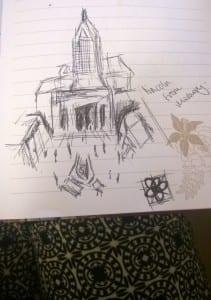Recently I have been thinking about the concept of memory and how reliable memories are. I have been thinking this more recently because I know that most of our work is based on the reliability of other people’s memories. The accounts of Florence Bonnett and other accounts of the goings on at the time are all based on memories. How much is fact, fiction and how has time distorted those memories. I tried to perform a mini experiment on my own memory. I decided to draw the city of Lincoln from memory, specifically the town centre, which should be the first picture below. The first picture is missing a lot of the cathedral, I have also in my memory added elements of the town which are not there.
.
In the second picture I had looked at an image of Lincoln and then proceeded to sketch what I had just seen, this demonstrates the difference of how time delays effect the memory,the shorter the time the better the memory. However, if the memory is a personal one there is a stronger connection to that image and therefore the time becomes secondary to the emotions of that memory.

A study on the effects of time delays and the role of emotion in relation to memory stated that “memory for emotionally arousing information will be persistent over time, whereas memory for neutral information will decline over time.” (Wang, 2014, p1) so the stronger the emotional link the memory the more likely you are to recall the event and its details. The accounts that we will be using I our piece will have had strong emotional links to the women at the time because of the environment and the situation they were having to live in a the time. Particularly the Beechey accounts of the war will have strong emotional times and will therefore be more reliable than, for example, the accounts given from a secondary source.
- Wang B (2014) Effect of Time Delay on Recognition Memory for Pictures: The Modulatory Role of Emotion. PLoS ONE 9(6): e100238. doi:10.1371/journal.pone.0100238